2. 中国科学院大学, 北京 100049;
3. 中国科学院地球科学研究院, 北京 100029;
4. 新疆地矿局物化探大队, 昌吉 831100
2. University of Chinese Academy of Sciences, Beijing 100049, China;
3. Institutions of Earth Science, Chinese Academy of Sciences, Beijing 100029, China;
4. Geophysical and Geochemical Exploration Team, Xinjiang Bureau of Geology and Mineral Exploration and Development, Changji 831100, China
喀喇昆仑地体处于金沙江缝合线和什约克缝合带之间,北接巴颜喀喇地体与西昆仑地体,南连科西斯坦-拉达克地体(图 1a),是研究特提斯构造演化、特别是西昆仑-喀喇昆仑构造演化的关键地区之一。近年来,对于喀喇昆仑地体基底特征及其与西昆仑地体的拼贴过程等前中生代构造演化有许多进展和共识(张传林等, 2007; 王春英等, 2009; 计文化等, 2011; 刘铮, 2015; 朱杰等, 2016)。但是,对喀喇昆仑地体中生代构造格架与演化特征研究较少,对发育于喀喇昆仑地体中林济塘盆地构造演化特征不清,对喀喇昆仑地体南侧的什约克洋片俯冲结束时间还存在不同认识(晚侏罗世,Murphy et al., 1997;早白垩世,Crawford and Searle, 1992; Matte et al., 1996; Heuberger et al., 2007; Jiang et al., 2014; 朱杰等, 2016; Chapman et al., 2018;晚白垩世,Jain and Singh, 2008; Li et al., 2016; Pan, 1996; Searle et al., 1987; Treloar et al., 1989;以及在40Ma之后,Bouilhol et al., 2013)。
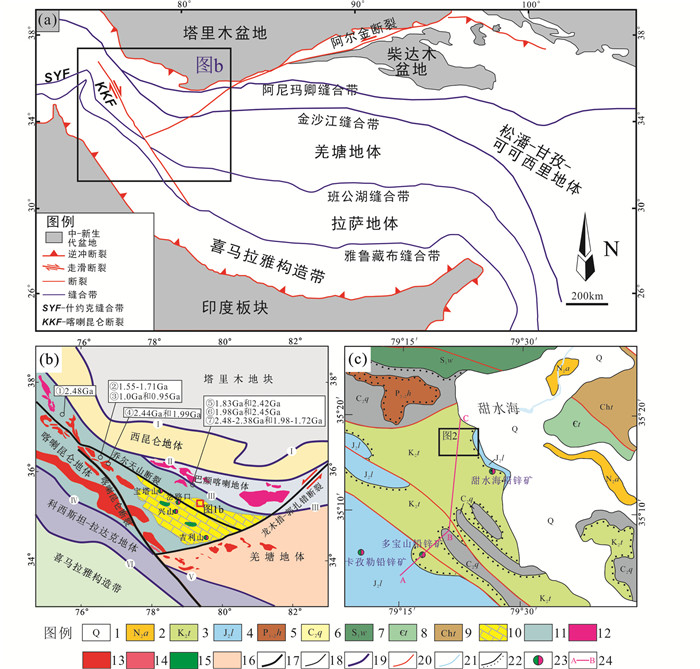
|
图 1 青藏高原及其西北部构造简图(a、b, 底图据Li et al., 2019)和甜水海区域地质图(c) 1-第四系;2-上新统阿图什组;3-上白垩统铁龙滩组;4-中侏罗统龙山组;5-二叠系红山湖组;6-上石炭统恰提尔群;7-下志留统下温泉沟群;8-寒武系甜水湖组;9-长城系甜水海岩群;10-林济塘中生代盆地;11-喀喇昆仑地体;12-三叠纪花岗岩;13-早白垩世花岗岩类;14-晚白垩世花岗岩类;15-侏罗纪玄武岩;16-羌塘地体;17-区域大断裂;18-地质界线;19-缝合带;20-断裂;21-河流;22-不整合界线;23-矿点;24-剖面位置;Ⅰ-库地-苏巴什缝合带;Ⅱ-康西瓦缝合带;Ⅲ-金沙江缝合带;Ⅳ-什约克缝合带;Ⅴ-班公湖缝合带;Ⅵ-雅鲁藏布缝合带;①布伦阔勒岩群流纹岩锆石U-Pb年龄(计文化等, 2011);②阿依里西花岗质斑岩继承锆石U-Pb年龄(朱杰等, 2016);③阿依里西花岗质斑岩继承锆石U-Pb年龄(朱杰等, 2016);④种羊场流纹岩继承锆石U-Pb年龄(胡军等, 2016);⑤大红柳滩铁矿含铁白云质大理岩继承锆石U-Pb年龄(Hu et al., 2016);⑥大红柳滩铁矿白云母石英片岩继承锆石U-Pb年龄(Hu et al., 2016);⑦大红柳滩二云母花岗岩继承锆石U-Pb年龄(魏小鹏等, 2017) Fig. 1 Structural sketch map of northwestern Tibetan Plateau (a, b, after Li et al., 2019) and geological map of the Tianshuihai area (c) 1-Quaternary; 2-Pliocene Atushi Fm.; 3-Late Cretaceous Tielongtan Fm.; 4-Middle Jurassic Longshan Fm.; 5-Permian Hongshanhu Fm.; 6-Late Carboniferous Qiatier Group; 7-Lower Wenquangou Group of Early Silurian; 8-Tianshuihu Fm. of Cambrian; 9-Tianshuihai Group of Changcheng System; 10-Linjitang Mesozoic basin; 11-Karakoram terrane; 12-Triassic granite; 13-Early Cretaceous granodiorite; 14-Early Cretaceous granite; 15-Early Cretaceous diorite; 16-Qiangtang terrane; 17-regional major fault; 18-geological boundary; 19-suture; 20-fault; 21-rivers; 22-unconformity; 23-deposits; 24-section position; Ⅰ-Kudi-Subashi suture; Ⅱ-Kangxiwa suture; Ⅲ-Jinshajiang suture; Ⅳ-Shyok suture; Ⅴ-Bangonghu suture; Ⅵ-Yarlung Zangbo suture; ① the zircon U-Pb age of rhyolite from the Bulunkuo Group (Ji et al., 2011); ② the zircon U-Pb age of granite porphyry from Ayilixi (Zhu et al., 2016); ③ the inherited zircon U-Pb age of granitic porphyry from Aylixi (Zhu et al., 2016); ④ the inherited zircon U-Pb age of rhyolite from Zhongyangchang (Hu et al., 2016b); ⑤ the inherited zircon U-Pb age of iron-bearing dolomitic marble from Dahongliutan iron mine (Hu et al., 2016); ⑥ the detritus zircon U-Pb age of muscovite quartz schist from Dahongliutan iron mine (Hu et al., 2016); ⑦ the inherited zircon U-Pb age of two-mica granite from Dahongliutan (Wei et al., 2017) |
近来,我们对林济塘中生代盆地地层与构造进行了调查,并在甜水海地区中侏罗统龙山组地层中发现了辉长岩侵入体。基于该岩体岩石学、地球化学、年代学和构造背景的研究,并结合新的地质构造资料,建立了区域中生代构造演化模式,以期为喀喇昆仑地区中生代构造演化过程提供新的信息与约束。
1 区域地质特征喀喇昆仑地体位于青藏高原西北缘。青藏高原西北缘北接塔里木地块,南邻喜马拉雅造山带(图 1a; Dewey et al., 1988; 潘裕生等, 1994; Yin and Harrison, 2000; Xiao et al., 2000, 2002, 2005; 张传林等, 2007),由8个构造单元组成,从北向南依次为库地-苏巴什缝合带、西昆仑地体、康西瓦缝合带、巴颜喀喇地体、金沙江缝合带、喀喇昆仑地体、什约克缝合带、科西斯坦-拉达克地体(图 1b; 许荣华等, 1994; 张传林等, 2007)。区域上喀喇昆仑地体被认为是羌塘地体的西向延伸(Yin and Harrison, 2000; 潘桂棠等, 2004)。
喀喇昆仑地体前寒武系到中新生代地层均有出露。三叠系地层主要由中三叠统河尾滩组和上三叠统克勒青河组成,中三叠统河尾滩组主要由深灰色结晶灰岩和砂质灰岩组成(崔建堂等, 2013),上三叠统克勒青河组为一套岩屑石英砂岩、泥岩、岩屑砂岩,被侏罗系地层不整合。侏罗-白垩系地层主要分布于喀喇昆仑地体的东南部,并被称为林济塘盆地(Pan et al., 2012),出露地层包括下侏罗统巴工布兰莎组、中侏罗统龙山组、中-上侏罗统红其拉甫组和上白垩统铁龙滩组(崔建堂等, 2013; 计文化等, 2013)。下侏罗统巴工布兰莎组形成在浅海环境下,由从下到上依次为灰色到紫色的砂岩和砾岩、灰色灰岩和石膏层。中侏罗统龙山组由下部砂岩,上部灰岩(层间含有玄武-安山岩夹层)组成(董连慧等, 2015)。中-上侏罗统红其拉甫组由生物碎屑,泥质灰岩层组成。铁龙滩组地层下部为一套粗碎屑岩、砂砾岩,上部为一套褐红色灰岩(图 2)。

|
图 2 甜水海-多宝山地质剖面图 1-中侏罗统龙山组;2-上白垩统铁隆滩组;3-砂岩;4-砂砾岩;5-灰岩;6-辉长岩;7-地质界线;8-角度不整合界线;9-剖面走向;10-断层;11-产状 Fig. 2 Geological section map of the Tianshuihai-Duobaoshan 1-Middle Jurassic Longshan Fm.; 2-Upper Cretaceous Tielongtan Fm.; 3-sandstone; 4-sand conglomerate; 5-limestone; 6-gabbro; 7-geological boundary; 8-angular unconformity; 9-section strike; 10-fault; 11-occurrence |
喀喇昆仑地体出露的岩浆岩主要为晚三叠世花岗岩、侏罗纪火山岩和白垩纪花岗岩类。晚三叠世岩浆岩主要分布在林济塘盆地以北靠近巴颜喀拉地体和慕士塔格的局部地区,岩石类型包括二云母花岗岩(~210Ma)、二长花岗岩(217~220Ma)、黑云二长花岗岩(230Ma)、花岗闪长岩(232Ma)(康磊等, 2015),形成于喀喇昆仑地体与巴颜喀喇地体挤压碰撞的构造背景(姜春发, 1992; 刘训等, 1997; 毕华等, 1999; 张传林等, 2005; 韩芳林, 2006; 杨文强等, 2011; 杨文强, 2013; 宋志冬, 2013; 乔耿彪等, 2015; 魏小鹏等, 2017; Zhang et al., 2019)。侏罗纪火成岩发育在林济塘盆地龙山组地层中,岩石类型以玄武质和安山质为主,有玄武岩、辉长岩与辉绿岩、安山岩与粗面安山岩,形成于弧后盆地的构造背景,主要分布于宝塔山、岔路口、兴山、吉利山等地区(Li et al., 2019)。早白垩世花岗闪长岩和英云闪长岩呈北西西向分布于红其拉甫-卡拉其古-乔戈里峰-温泉一带(潘桂棠, 2004; 李荣社等, 2008; Pan et al., 2012; Jiang et al., 2014),岩体年龄为103~121Ma(Heuberger et al., 2007; Ravikant et al., 2009; Jiang et al., 2014; Li et al., 2016)。晚白垩世花岗岩以林济塘南侧潘公的层状和片麻状花岗岩(73Ma, Ravikant et al., 2009)和红其拉甫的闪长岩(100Ma, Li et al., 2016)为主。白垩纪花岗岩类被认为是什约克洋片北向俯冲于喀喇昆仑地体之下形成的岩浆弧(丁道桂等, 1996; 姜春发等, 2000; Bhutani et al., 2003; 李荣社等, 2008)。
喀喇昆仑地体大型断裂主要包括喀喇昆仑断裂、乔尔天山断裂和龙木错-郭扎错断裂(图 1b)。喀喇昆仑断裂带是喜马拉雅山脉北部重要的右旋走滑断裂带,断裂带大略呈NW-SE走向,平行于喜马拉雅西部山脉,其分布从冈仁波齐(神山)至帕米尔长约1200km,形成时代约23Ma(李海兵等, 2006, 2007; Chevalier, 2019)。林济塘盆地为弧后盆地(李荣社等, 2008; Pan et al., 2012; Li et al., 2019),位于喀喇昆仑地体的东南部,被龙木错-郭扎错断裂截切,并被乔尔天山断裂穿切。喀喇昆仑地体褶皱构造发育,其中林济塘中生代盆地侏罗系地层发生强烈褶皱(图 2, 崔建堂等, 2013; 计文化等, 2013),并被上白垩统铁龙滩组不整合。上白垩统铁龙滩组地层整体较平缓。林济塘中生代盆地不整合包括平行不整合和角度不整合,其中主要发育的是上白垩统铁龙滩组地层角度不整合于中侏罗统龙山组地层之上(图 2),中侏罗统龙山组平行不整合于下侏罗统巴工布兰莎组之上。
2 岩体地质与岩石学特征甜水海辉长岩发现于林济塘盆地北部(图 1c)。研究区出露的地层以中侏罗统龙山组和上白垩统铁龙滩组为主。中侏罗统龙山组与上白垩统铁龙滩组间为不整合接触,龙山组主要包括下部砂岩和上部灰岩(层间含有玄武-安山岩夹层)(董连慧等, 2015)。铁龙滩组地层下部为一套粗碎屑岩、砂砾岩,上部为一套褐红色灰岩(图 3a, b)。
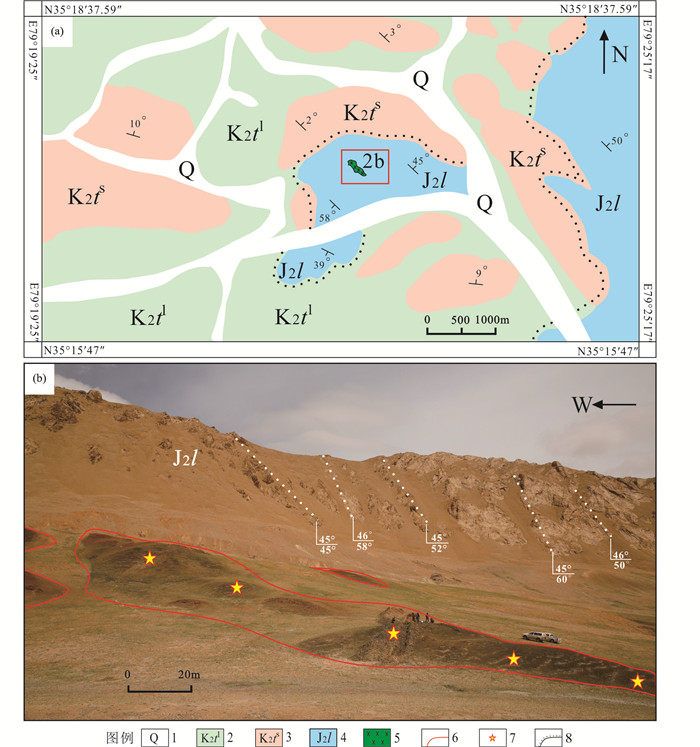
|
图 3 甜水海地区地质图(a)和野外照片(b) 1-第四系;2-白垩系铁龙滩组灰岩;3-白垩系铁龙滩组砂岩;4-侏罗系龙山组灰岩;5-辉长岩岩体;6-岩体界线;7-采样点;8-角度不整合接触界线 Fig. 3 Geological map (a) and filed photograph (b) of the Tianshuihai area 1-Quaternary; 2-limestone of Cretaceous Tielongtan Fm.; 3-sandstone of Cretaceous Tielongtan Fm.; 4-limestone of Jurassic Longshan Fm.; 5-gabbro pluton; 6-pluton boundary; 7-sample collecting points; 8-angular unconformity |
辉长岩岩体侵位于侏罗系龙山组灰岩中,呈透镜状断续出露,整体沿北西-南东向延伸,宽可达72m,长累计约305m(图 3b)。经追索辉长岩岩体并未侵入到铁龙滩组灰岩中。
辉长岩手标本呈灰绿色,中粒结构,块状构造(图 4a)。主要造岩矿物为单斜辉石、斜长石、钾长石、角闪石和黑云母。其中单斜辉石含量25%~35%(透辉石含量15%~20%、普通辉石含量10%~15%),呈半自形-自形短柱状;斜长石含量45%~50%,呈半自形板柱状;角闪石含量5%~10%,呈他形粒状;钾长石含量3%~5%,呈半自形-自形柱状;黑云母含量2%~5%,呈片状(图 4b)。辉长岩呈典型的辉长结构,其中斜长石长宽比大于5:1,可见聚片双晶;辉石粒径0.2~0.5mm,可见完全解理。

|
图 4 甜水海辉长岩手标本(a)及正交偏光镜下照片(b) Pl-斜长石;Di-透辉石;Aug-普通辉石 Fig. 4 Hand specimen (a) and microscopic picture under cross-polarized light (b) of gabbro from the Tianshuihai area Pl-plagioclase; Di-diopside; Aug-augit |
针对辉长岩样品开展了系统的地球化学、同位素年代学研究。样品采集按等距离贯穿岩体完成,采集的样品较新鲜。
对辉长岩岩石样品进行主、微量测试(5件:16TSH06-3、16TSH06-4、16TSH06-7、16TSH06-8、16TSH06-11)、全岩Rb-Sr-Sm-Nd同位素测试(16TSH06-4、16TSH06-7)及锆石LA-ICP-MS U-Pb测年(16TSH05)。
3.1 主量与微量元素样品主量与微量元素分析测试工作均在在中国科学院矿产资源研究院重点实验室完成。主量元素的测定采用X-射线荧光光谱法(XRF):首先称取0.5g样品放入坩埚,然后加入适量硼酸高温熔融成玻璃片,最后在日本岛津公司生产的顺序式X射线荧光光谱仪(XRF-1500)上采用外标法测定氧化物含量,分析误差小于5%。主量元素分析结果列于表 1,并借助Geokit 2012(路远发, 2004)计算程序得到岩石的主要岩石化学参数。
|
|
表 1 甜水海地区辉长岩主量元素(wt%)和微量元素(×10-6)分析结果 Table 1 Major element (wt%) and trace element (×10-6) analysis results of gabbro from the Tianshuihai area |
微量元素的测定采用ICP-MS法,称取40mg样品用酸溶法制成溶液,然后在ICP-MS Element Ⅱ上进行测定,其精度为:元素含量小于10×10-6的误差小于10%,大于10×10-6的误差小于5%。具体分析方法参见李献华等(2002)。岩石稀土元素及微量元素测试结果列于表 1,运用Geokit 2012(路远发, 2004)对稀土元素数据采用原始地幔数据(Sun and McDonough, 1989)进行标准化,并计算主要的稀土元素参数。
3.2 锆石U-Pb测年锆石U-Pb同位素定年分析在武汉上谱分析科技有限责任公司利用LA-ICP-MS分析完成。详细的仪器参数和分析流程见(Zong et al., 2017)。GeolasPro激光剥蚀系统由COMPexPro102 ArF193nm准分子激光器和MicroLas光学系统组成,ICP-MS型号为Agilent 7700e。激光剥蚀过程中采用氩气为补偿气、氦气作载气以调节灵敏度,二者在进入ICP之前通过一个T型接头混合,激光剥蚀系统配置有信号平滑装置(Hu et al., 2015)。本次分析的激光束斑和频率分别为32μm和5Hz。U-Pb同位素定年和微量元素含量处理中采用锆石标准91500和玻璃标准物质NIST 610作外标分别进行同位素和微量元素分馏校正。每个时间分辨分析数据包括大约20~30s空白信号和50s样品信号。对分析数据的离线处理(包括对样品和空白信号的选择、仪器灵敏度漂移校正、元素含量及U-Pb同位素比值和年龄计算)采用软件ICPMSDataCal(Liu et al., 2008, 2010)完成。锆石样品的U-Pb年龄谐和图绘制和年龄加权平均计算采用Isoplot/Ex_ver3(Ludwig, 2003)完成。数据处理结果见表 2。
|
|
表 2 甜水海地区辉长岩(样品16TSH05)中锆石LA-ICP-MS U-Pb定年结果 Table 2 LA-ICP-MS zircon U-Pb dating results for gabbro (Sample 16TSH05) from the Tianshuihai area |
全岩Sr-Nd同位素样品的前处理在中国科学院岩石圈演化国家重点实验室的超净实验室完成,同位素比值测量在中国科学院地质与地球物理研究所固体同位素地球化学实验室的MAT-262型热电离质谱仪上完成,详细的Sr-Nd同位素测定流程遵照Li et al. (2012)和Yang et al. (2010)。分别采用146Nd/144Nd=0.7219和86Sr/88Sr=0.1194校正Nd和Sr同位素比值。国际标样NbS-987和JNdi-1用来评估测量数据收集过程中的仪器稳定性,本次测定过程中NbS-987的87Sr/86Sr=0.710236±0.000010 (2σ, n=4),JNdi-1的143Nd/144Nd=0.512124±0.000012(2σ, N=4)。USGS标样BCR-2被用来监测分析流程的精确度,本次测量过程中,BCR-2的87Sr/86Sr=0.715021±0.000015,143Nd/144Nd=0.512635±0.000011,和应用TIMS以及MC-ICP-MS方法得到的测量结果(Li et al., 2012)在误差范围内保持一致。对岩石样品按其岩浆锆石U-Pb年龄(102Ma)推算它们的(87Sr/86Sr)i、(143Nd/144Nd)i、εNd(t)等值。同位素分析结果及参数列于表 3。
|
|
表 3 甜水海辉长岩Sr、Nd同位素组成 Table 3 Sr-Nd isotopic composition of gabbro from the Tianshuihai area |
辉长岩样品SiO2含量变化范围为49.84%~51.52%,平均含量50.4%,属于基性岩类。Al2O3含量为15.07%~15.32%,平均含量15.22%。MgO含量为8.00%~9.15%,平均含量8.43%。TiO2含量为1.31%~1.34%,平均含量1.33%。K2O含量为0.47%~0.64%,平均含量0.56%。Na2O含量为2.89%~3.14%,平均含量3.06%。镁指数Mg#为40.9~42.9,平均含量41.6。全碱(Na2O+K2O)含量为3.49%~3.72%,铝饱和指数A/CNK为1.16~1.43,里特曼指数σ为1.53~2.01(表 1)。
在TAS图解中,样品落在亚碱性辉长岩范围内,与岩相学特征一致(图 5a)。在SiO2-K2O(图 5b)和FAM(图 5c)图解中,样品大多位于钙碱系列区域。从Ta/Yb-Th/Yb图解中(图 5d)可看出,甜水海辉长岩产于板内环境。在Zr/Sm-(La/Sm)N和Y/Pb-(La/Sm)N图解中,甜水海辉长岩样品多落入地壳附近(图 6)。
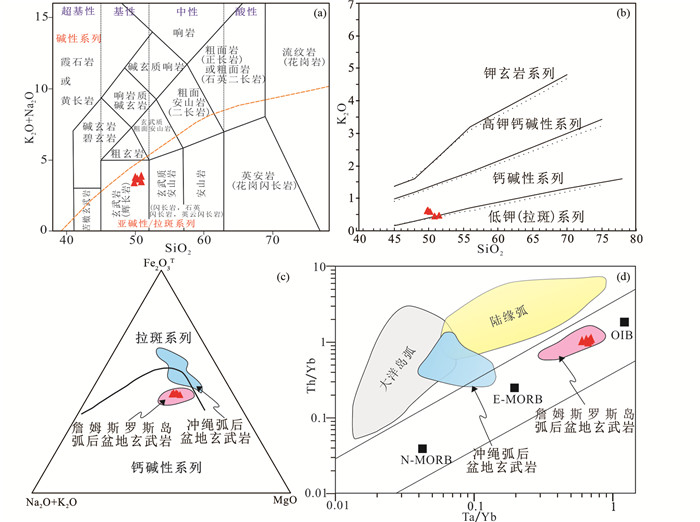
|
图 5 甜水海辉长岩TAS图解(a, 据Middlemost, 1994)、SiO2-K2O(b, 据Peccerillo and Taylor, 1976; Middlemost, 1985)、FAM(c, 据Irvine and Baragar, 1971)及Ta/Yb-Th/Yb图解(d, 据Pearce, 1982) 詹姆斯罗斯岛弧后盆地玄武岩数据引自Košler et al. (2009);冲绳弧后盆地玄武岩数据引自Shinjo et al. (1999);N-MORB、E-MORB、OIB数据引自Sun and McDonough (1989) Fig. 5 TAS diagram (a, after Middlemost, 1994), SiO2 vs. K2O diagram (b, after Peccerillo and Taylor, 1976; Middlemost, 1985), FAM diagram (c, after Irvine and Baragar, 1971) and Ta/Yb vs. Th/Yb diagram (d, after Pearce, 1982) of gabbro from the Tianshuihai area The values of James Ross Island BABB from Košler et al. (2009); the values of Okinawa BABB from Shinjo et al. (1999); the values of N-MORB, E-MORB and OIB from Sun and McDonough (1989) |
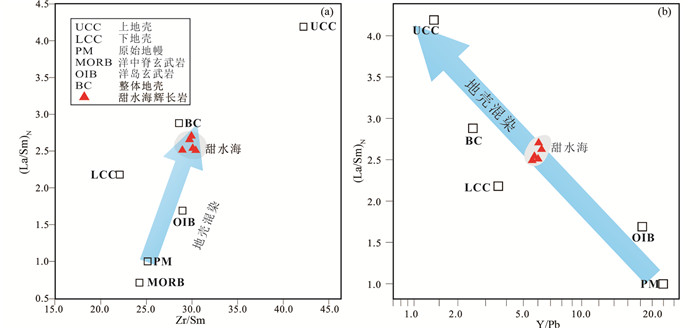
|
图 6 甜水海辉长岩Zr/Sm-(La/Sm)N (a)和Y/Pb-(La/Sm)N (b)图解 PM值据Hofmann (1988);MORB、OIB、UCC、LCC、BC值据Taylor and McLennan (1985) Fig. 6 Zr/Sm vs. (La/Sm)N (a) and Y/Pb vs. (La/Sm)N (b) diagrams of gabbro from the Tianshuihai area PM data from Hofmann (1988); MORB, OIB, UCC, LCC, BC data from Taylor and McLennan (1985) |
辉长岩样品稀土元素含量(∑REE)为83.0×10-6~92.2×10-6,平均为86.6×10-6。δCe的平均值为0.92(表 2)。在球粒陨石标准化稀土元素配分图上(图 7a),样品呈富集轻稀土元素(LREE)、贫重稀土元素(HREE)的右倾型配分型式((La/Yb)N=6.17~7.39)且轻重稀土分馏比较明显(LREE/HREE=5.21~5.78,均值5.46)。重稀土斜率较为平坦((Gd/Yb)N=1.76~2.03,均值1.90),而轻稀土斜率相对较大((La/Sm)N=2.56~2.77,均值2.65),稀土配分曲线整体与洋岛玄武岩(OIB)、詹姆斯罗斯岛弧后盆地玄武岩整体趋势相似(图 7)。样品中均具有富集La、Th、Nd与Tb,亏损Rb、Ce、Y、Sr与P元素的特征,除U、Th外,样品的微量元素蛛网图与OIB、詹姆斯罗斯岛弧后盆地玄武岩相似。

|
图 7 甜水海辉长岩球粒陨石标准化稀土元素配分模式图(a, 标准化值据Boynton, 1984)和原始地幔标准化微量元素蛛网图(b, 标准化值据Sun and McDonough, 1989) N-MORB、E-MORB和OIB值据Sun and McDonough (1989);詹姆斯罗斯岛弧后盆地玄武岩数据引自Košler et al. (2009);阿留申弧玄武岩数据引自Stelling et al. (2002), George et al. (2003), Jicha et al. (2004), Jicha and Singer (2006), Finney et al. (2008)及Mangan et al. (2009) Fig. 7 Chondrite-normalized REE patterns (a, normalization values after Boynton, 1984) and primitive mantle-normalized trace element spidergrams (b, normalization values after Sun and McDonough, 1989) diagrams of gabbro from the Tianshuihai area Data for the N-MORB, E-MORB and OIB from Sun and McDonough (1989); the values of James Ross Island BABB from Košler et al. (2009); the compositions of Aleutian arc basalts compiled from Stelling et al. (2002), George et al. (2003), Jicha et al. (2004), Jicha and Singer (2006), Finney et al. (2008) and Mangan et al. (2009) |
鉴于甜水海辉长岩岩体侵位于中侏罗统龙山组地层中,岩体侵位时间应晚于中侏罗世(164Ma)。结合锆石CL图像(图 8a, b)和锆石年龄将甜水海辉长岩锆石分为两类。一类为岩浆锆石:以半自形-自形、长柱状为主,锆石多呈灰-灰白色、透明,晶形较完整,CL图像显示该类锆石具有清晰的震荡环带,是典型的岩浆成因(Hoskin and Schaltegger, 2003),震荡环带较清晰且年龄较小的一组锆石(G01~G14);另一类为继承锆石:以半自形-不规则次圆状、长柱状为主,大小不一,锆石多呈灰-灰黑白色、透明,晶形较好,少数锆石具碎裂现象,根据年龄分布和CL图像将其分为两组。第一组为岩浆成因的继承锆石(G15~G46),CL图像亦具有清晰的震荡环带,年龄分布不集中;第二组继承锆石(G47~G52)CL图像显示其表面呈灰黑色且环带不发育。
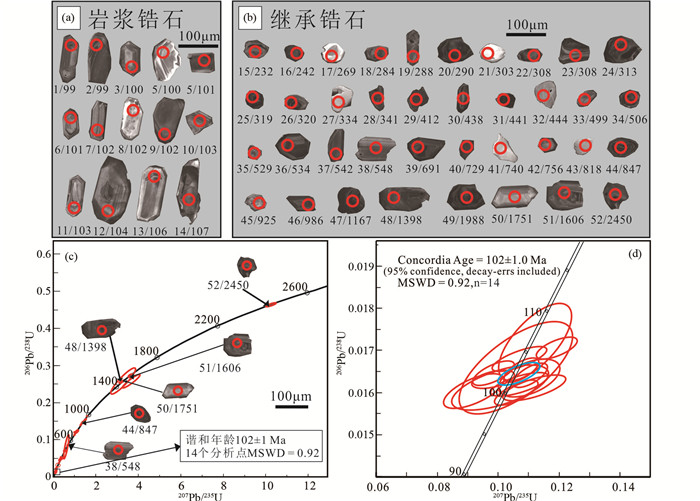
|
图 8 甜水海辉长岩锆石CL图像及U-Pb定年测点位置(a、b)和锆石U-Pb年龄谐和曲线(c、d) 1/99.3代表 1号锆石测点206Pb-238U年龄为99.3Ma,红圆圈为测点位置;年龄 < 1000Ma的锆石,以206Pb/238U年龄表示,年龄>1000Ma的锆石,以207Pb/206Pb年龄表示 Fig. 8 Cathodoluminescence (CL) images and measuring positions of zircon grains (a, b), concordia diagrams of zircon U-Pb ages (c, d) from gabbro in the Tianshuihai area 1/99.3 represents that the 206Pb-238U age of the No.1 zircon is 99.3Ma, the red ellipses show the LA-ICP-MS analysis location; zircons age < 1000Ma, was applied in 206Pb/238U apparent age, zircons age >1000Ma, was applied in 207Pb/206Pb apparent age |
第一类锆石(G01~G14),锆石Th、U与Pb含量分别为178×10-6~795×10-6、285×10-6~1078×10-6、18×10-6~78×10-6,Th/U比值在0.4~1.0之间,显示出岩浆锆石的特点(表 2; 图 8a; Hoskin and Schaltegger, 2003),锆石206Pb/238U年龄在99.3~107Ma之间,平均年龄为102±1Ma(图 8d, MSWD=0.92; n=14);第二类锆石为岩浆侵位过程中从围岩捕获的继承锆石:第一组锆石(G15~G46)U、Th与Pb含量分别为17×10-6~1288×10-6、5×10-6~1104×10-6、4×10-6~439×10-6,Th/U比值在0.3~1.3之间,其年龄数据较分散且跨度很大,从三叠纪到新元古代均有出现(232~986Ma);第二组锆石(G47~G52)呈短柱状、浑圆状,锆石U、Th与Pb含量分别为121×10-6~471×10-6、61×10-6~289×10-6、96×10-6~584×10-6,Th/U比值在0.4~1.1之间,207Pb/206Pb年龄为1167~2450Ma(图 8b)。
4.3 全岩Sr-Nd同位素样品(16TSH06-4、16TSH06-7)的(87Sr/86Sr)i值和(143Nd/144Nd)i值分别为0.70577、0.706398和0.512203、0.512210。(87Sr/86Sr)i值均高于原始地幔初始值(0.7045; DePaolo, 1988),εNd(t)值分别为-5.8、-5.9,(143Nd/144Nd)i值低于原始地幔值(0.512638; Jacobsen and Wasserburg, 1980), 岩石的地幔模式年龄tDM在1775~1811Ma之间(表 3)。在(87Sr/86Sr)i-(143Nd/144Nd)i图解(图 9)上样品均落入Ⅰ型富集地幔与甜水海地壳之间的区域。
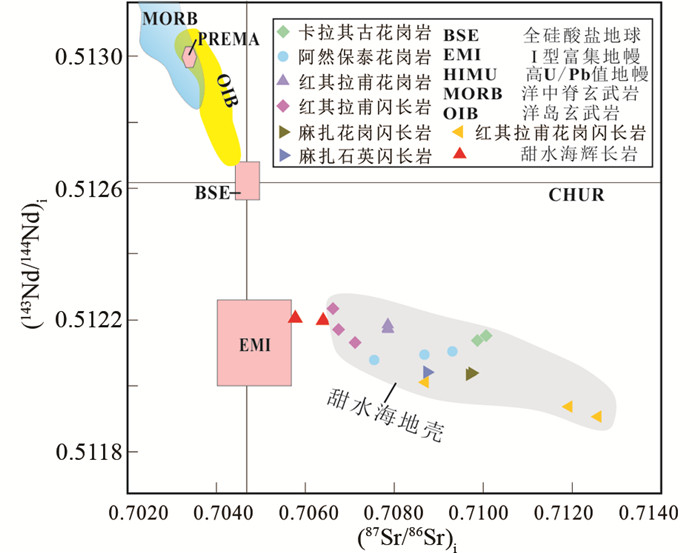
|
图 9 甜水海辉长岩(87Sr/86Sr)i-(143Nd/144Nd)i图解(底图据Zindler and Hart, 1986) PREMA值据Hofmann (1988);MORB、OIB、BSE值据Taylor and McLennan (1985).卡拉其古、阿然保泰和红其拉甫花岗岩Sr-Nd值据Jiang et al. (2014);红其拉甫闪长岩和花岗闪长岩Sr-Nd值据Li et al. (2016);麻扎石英闪长岩和花岗闪长岩Sr-Nd值据Liu et al. (2015) Fig. 9 (87Sr/86Sr)i vs. (143Nd/144Nd)i diagram of gabbro from the Tianshuihai area (base map after Zindler and Hart, 1986) PREMA data from Hofmann (1988); MORB, OIB, BSE data from Taylor and McLennan (1985); granite Sr-Nd data of Kalaqigu, Aranbaota and Hongqilafu from Jiang et al. (2014); diorite and granodiorite Sr-Nd data of Hongqilafu from Li et al. (2016); quartz diorite and granodiorite Sr-Nd data of Mazha from Liu et al. (2015) |
由于甜水海辉长岩侵位于中侏罗统龙山组地层中,而没有侵入到上白垩统铁龙滩组,说明岩体形成于中侏罗世之后晚白垩世之前。辉长岩第一类岩浆锆石14个测点(G01~G14)给出了一组加权平均年龄为102±1Ma(MSWD=0.92, n=14),可代表辉长岩岩体的年龄。与喀喇昆仑天文点一带辉长岩的年龄(105±4Ma)一致(菅坤坤等, 2018),表明早白垩世晚期的基性岩浆活动在区域上是较广泛的。
第二类第一组岩浆成因锆石(G15~G46)为继承锆石,根据其年龄范围将其分为两个年龄段进行解释:(1)第1年龄段继承锆石的年龄为412~986Ma,主要集中区间为412~548Ma。与康西瓦一带的三十里营房年龄为447Ma的俯冲型石英闪长岩(崔建堂等, 2006)及许志琴等(2004)在康西瓦一带发现的年龄为428~492Ma的加里东期孔兹岩系相对应,属于加里东期构造旋回岩浆作用的产物(朱杰等, 2016)。(2)第2年龄段继承锆石的年龄为232~341Ma,记录了晚古生代及中生代喀喇昆仑与西昆仑地体的构造演化过程。可能产生于250~240Ma喀喇昆仑与西昆仑地体沿着康西瓦缝合带碰撞(张传林等, 2005)和240~200Ma期间的后碰撞伸展环境(张传林等, 2005; 康磊等, 2012; Liu et al., 2015; Zhang et al., 2019)。
第二类第二组年龄较老的锆石(G47~G52),结晶年龄主要有1167~1751Ma、1988~2450Ma两个阶段,与前人关于甜水海地区的古老基底测年结果范围基本相一致(图 1b; 计文化等, 2011; 朱杰等, 2016; 胡军等, 2016, 2017; 魏小鹏等, 2017),进一步证实了甜水海地块存在前寒武纪结晶基底。
5.2 辉长岩的岩浆源区特征与构造背景甜水海辉长岩具负的εNd(t)值(2个样品分别为-5.8、-5.9),富集La、Pb、Th与Nd,亏损Rb、Nb、Ta、Ce、Pr与P,在(87Sr/86Sr)i-(143Nd/144Nd)i图解(图 9)上样品均落入Ⅰ型富集地幔与甜水海地壳之间的区域,Sc值介于18.7×10-6~20.3×10-6之间(Frey and Prinz, 1978)的特征,这些特征说明辉长岩样品的源区可能为富集型岩石圈地幔。
甜水海辉长岩中大量继承锆石的发育意味着岩浆在上升过程中有陆壳物质的混入与混染,这一结论还被下面的现象与资料所佐证:(1)样品中Sr含量(195×10-6~226×10-6)显著高于地幔值(17.8×10-6; Taylor and McLennan, 1985; McCulloch and Gamble, 1991; Hawkesworth et al., 1993),而辉长岩样品的源区为富集型岩石圈地幔;(2)地壳中Ce/Pb < 15,而典型地幔Ce/Pb=25±5(Hofmann, 1986),本文辉长岩样品中Ce/Pb为9.72~11.3,处于地壳和典型地幔之间;(3)洋中脊玄武岩和洋岛玄武岩Nb/U比值为47±10,而大陆地壳和原始地幔Nb/U平均值分别为8.93、33.59(Taylor and McLennan, 1985; Hofmann, 1986; 曹圣华等, 2006; 莫宣学和潘桂棠, 2006; 邓晋福等, 2015),本文辉长岩样品中Nb/U为26.6~29.1,处于大陆地壳和原始地幔Nb/U平均值之间;(4)样品中La/Nb比值在1.33~1.47之间,均大于1(袁超等, 2005; 夏林圻等, 2006, 2008);另外,微量元素蛛网图(图 7)显示辉长岩样品中Pb的含量位于上地壳和洋岛玄武岩之间;(5)在Zr/Sm-(La/Sm)N和Y/Pb-(La/Sm)N图中(图 6),样品的(La/Sm)N值位于地壳和地幔之间,这意味着甜水海辉长岩岩浆受到地壳混染。
甜水海辉长岩缺少明显的Nb、Ta负异常,不同于弧玄武岩(图 7b)。又因为其为钙碱性系列岩石(图 5b, c),源区为富集岩石圈地幔,所以排除其形成于洋中脊环境。甜水海辉长岩具有较高的Th/Yb值(位于1.07~1.16之间),在Ta/Yb-Th/Yb图投点位于板内玄武岩区,与弧后盆地玄武岩的地化性质相似(图 5d),结合其含有大量碎屑锆石及前寒武纪基底,排除其形成于洋岛环境(图 5d)。甜水海辉长岩与正常的弧后盆地玄武岩有明显的差异,其元素和同位素特征与弧后盆地玄武岩的亚族(詹姆斯罗斯岛弧后盆地玄武岩)类似(图 5d, Košler et al., 2009),詹姆斯罗斯岛弧后盆地玄武岩为弧后盆地拉开前的玄武岩(Shuto et al., 2004, 2006),具有明显富集LREE、LILE和HFSE的特征(Gorring et al., 2003; Guivel et al., 2006; Košler et al., 2009; Shuto et al., 2006; Sinton et al., 2003; Wang et al., 2007),不同于MORB(图 5d、图 7),这种玄武岩与成熟弧后盆地玄武岩有明显的差异。在FAM图解(图 5c)中甜水海辉长岩与詹姆斯罗斯岛弧后盆地玄武岩投点位于钙碱性系列,不同于以冲绳弧后盆地玄武岩为代表的正常弧后盆地玄武岩,可能与甜水海辉长岩形成于伸展背景的初始阶段有关。所以判定甜水海辉长岩形成于陆内伸展体制。即102Ma时,甜水海地区处于伸展构造背景。这与甜水海辉长岩侵位于褶皱的中侏罗统龙山组灰岩中并被上白垩统铁龙滩组砂砾岩和灰岩不整合的特征所显示的晚白垩世时甜水海地区为海相盆地环境、为伸展构造背景的结论是一致的。
综上,甜水海辉长岩岩浆的源区可能为富集型岩石圈地幔,其侵位过程中经历了地壳混染作用,形成于板内伸展背景。
5.3 区域构造演化林济塘盆地侏罗系灰岩地层和龙山组地层中玄武岩建造的发育,说明侏罗纪林济塘海盆形成于伸展构造背景。鉴于林济塘盆地西侧乔戈里峰-温泉一带早白垩世岩浆弧的发育(潘桂棠, 2004; 李荣社等, 2008; Pan et al., 2012; Jiang et al., 2014),可以认为侏罗纪-早白垩世早期的林济塘盆地为弧后盆地(李荣社等, 2008; Pan et al., 2012),形成于什约克洋片的北向俯冲。林济塘盆地中侏罗统龙山组地层发生褶皱并被上白垩统铁龙滩组不整合(缺失早白垩世地层),说明喀喇昆仑地体在早白垩世发生造山作用,这意味着什约克洋片在早白垩世期间曾发生平板俯冲作用。这种造山作用与45Ma时美国西部洋底岩石圈的浅俯冲导致区域岩浆活动停止并形成Sevier、Laramide造山带(Yonkee and Weil, 2015)及与南美安第斯低角度俯冲造山相似(Elger et al., 2005; Sobolev and Babeyko, 2005; Cawood et al., 2009)。甜水海地区102Ma辉长岩的发育意味着在102Ma时该地区又进入伸展构造背景。上白垩统铁龙滩组砂砾岩与灰岩的发育意味着较大海盆的形成。林济塘盆地南侧潘公等地晚白垩世时弧花岗岩的发育(100~73Ma, Ravikant et al., 2009)说明晚白垩世时林济塘盆地仍为弧后盆地。基于此,我们认为喀喇昆仑地体中生代的构造演化经历了3个阶段(图 10):
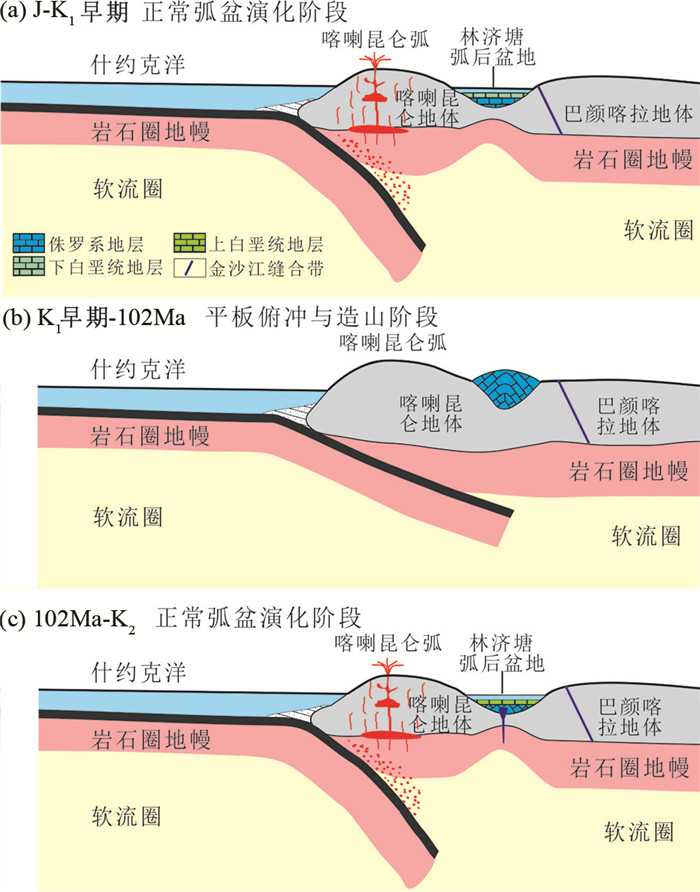
|
图 10 甜水海地区中生代构造演化模式图 Fig. 10 Tectonic evolution model in Mesozoic of the Tianshuihai area |
(1) J至K1早期正常弧盆演化阶段(图 10a):什约克洋片向北正常俯冲,形成中生代喀喇昆仑地体岩浆弧及林济塘弧后盆地。林济塘弧后盆地在中-晚侏罗世时强烈拉伸并发育玄武岩建造。
(2) K1早期至102Ma平板俯冲与造山阶段(图 10b):什约克洋片开始由向北的正常俯冲变为平板俯冲,导致弧岩浆活动停止(Yonkee and Weil, 2015; Dailey et al., 2018)、侏罗系地层发生褶皱以及下白垩统地层缺失。这种挤压作用可能与平板俯冲导致的区域挤压与隆升有关,与南美安第斯低角度俯冲造山相似。
(3) 102Ma至K2正常弧盆演化阶段(图 10c):102Ma时,什约克洋片俯冲角度开始变陡,林济塘地区再次发生弧后扩张形成伸展盆地,深部软流圈的物质伴随着地壳在张应力下开始减薄发生快速上涌,大量的热使上覆的岩石圈地幔发生减压部分熔融,在102Ma时形成甜水海辉长岩。在晚白垩世时完全变为海相盆地,发育海相地层。
6 结论新发现的甜水海辉长岩锆石LA-ICP-MS U-Pb年龄为102±1Ma,形成于早白垩世晚期。辉长岩中大量古老继承锆石的发育意味着研究区存在前寒武纪基底,且岩浆经历了强烈的地壳混染。甜水海辉长岩富集LREE及部分LILE,相对亏损HREE,形成于板内伸展的构造背景。其发育意味着林济塘地区早白垩世晚期再次进入伸展与弧后盆地发育阶段。喀喇昆仑地体中生代经历了三阶段的构造演化,即侏罗纪-早白垩世早期的正常俯冲与弧盆演化、早白垩世的平板俯冲与造山阶段、及晚白垩世的正常俯冲与弧盆演化。
致谢 论文相关野外地质调查及样品采集工作得到了新疆地矿局第八地质大队范廷宾总工程师及全体项目组工作人员的大力支持;室内研究工作得到了中国科学院地质与地球物理研究所主、微量实验室、固体同位素地球化学实验室的大力帮助与支持;两位审稿人百忙之中对本文的审阅并提出建设性问题及建议,使得本文能更加规范、完整,内容上也更加严谨、充实。在此向他们表示衷心感谢!
Bhutani R, Pande K and Desai N. 2003. Age of the Karakoram fault activation: 40Ar-39Ar geochronological study of Shyok suture zone in northern Ladakh, India. Current Science, 84: 1454-1458 |
Bi H, Wang ZG, Wang YL and Zhu XQ. 1999. The Evolution of magma in orogenic belt, West Kunlun. Science in China (Series D), 29(5): 398-406 (in Chinese) |
Bouilhol P, Jagoutz O, Hanchar JM and Dudas FO. 2013. Dating the India-Eurasia collision through arc magmatic records. Earth and Planetary Science Letters, 366: 163-175 |
Boynton WV. 1984. Cosmochemistry of the rare earth elements: Meteorite studies. Developments in Geochemistry, 2: 63-114 |
Cao SH, Deng SQ, Xiao ZJ and Liao LG. 2006. The archipelagic arc tectonic evolution of the Meso-Tethys in the western part of the Bangong Lake-Nujiang suture zone. Sedimentary Geology and Tethyan Geology, 26(4): 25-32 (in Chinese with English abstract) |
Cawood PA, Kröner A, Collins WJ, Kusky TM, Mooney WD and Windley BF. 2009. Accretionary orogens through Earth history.In: Cawood PA and Kröner A (eds.). Earth Accretionary Systems in Space and Time. Geological Society, London, Special Publications, 318: 1-36 |
Chapman JB, Scoggin SH, Kapp P, Carrapa B, Ducea MN, Worthington J, Oimahmadov I and Gadoev M. 2018. Mesozoic to Cenozoic magmatic history of the Pamir. Earth and Planetary Science Letters, 482: 181-192 |
Chevalier ML. 2019. Active tectonics along the Karakorum Fault, western Tibetan Plateau: A review. Acta Geoscientica Sinica, 40(1): 37-54 |
Crawford MB and Searle MP. 1992. Field relationships and geochemistry of pre-collisional (India-Asia) granitoid magmatism in the central Karakoram, northern Pakistan. Tectonophysics, 206(1-2): 171-192 |
Cui JT, Wang JC, Bian XW and Zhu HP. 2006. Geological characteristics of Early Paleozoic quartz diorite in the vicinity of Kangxiwar, West Kunlun, China and its zircon SHRIMP U-Pb dating. Geological Bulletin of China, 25(12): 1450-1457 (in Chinese with English abstract) |
Cui JT, Wang JC and Bian XW. 2013. Regional Geological Survey Report of the People's Republic of China: 1 250000, Chalukou Sheet (I44C001001). Wuhan: China University of Geosciences Press (in Chinese)
|
Dailey SR, Christiansen EH, Dorais MJ, Kowallis BJ, Fernandez DP and Johnson DM. 2018. Origin of the fluorine- and beryllium-rich rhyolites of the Spor Mountain Formation, Western Utah. American Mineralogist, 103(8): 1228-1252 |
Deng JF, Feng YF, Di YJ, Liu C, Xiao QH, Su SG, Zhao GC, Meng F, Ma S and Yao T. 2015. Magmatic arc and ocean-continent transition: Discussion. Geological Review, 61(3): 473-484 (in Chinese with English abstract) |
DePaolo DJ. 1988. Age dependence of the composition of continental crust: Evidence from Nd isotopic variations in granitic rocks. Earth and Planetary Science Letters, 90(3): 263-271 |
Dewey JF, Shackleton RM, Chang CF and Sun YY. 1988. The tectonic evolution of the Tibetan Plateau. Philosophical Transactions of the Royal Society A: Mathematical, Physical and Engineering Sciences, 327(1594): 379-413 |
Ding DG, Wang DX, Liu WX and Sun SQ. 1996. The Western Kunlun Orogenic Belt and Basin. Beijing: Geological Publishing House, 183-217 (in Chinese)
|
Dong LH, Xu XW, Fan TB, Qu X, Li H, Wan JL, An HT, Zhou G, Li JH, Chen G and Liu C. 2015. Discovery of the Huoshaoyun super-large exhalative-sedimentary carbonate Pb-Zn deposit in the Western Kunlun area and its great significance for regional metallogeny. Xinjiang Geology, 33(1): 41-50 (in Chinese with English abstract) |
Elger K, Oncken O and Glodny J. 2005. Plateau-style accumulation of deformation: Southern Altiplano. Tectonics, 24(4): TC4020 |
Finney B, Turner S, Hawkesworth C, Larsen J, Nye C, George R, Bindeman I and Eichelberger J. 2008. Magmatic differentiation at an island-arc caldera: Okmok volcano, Aleutian Islands, Alaska. Journal of Petrology, 49(5): 857-884 |
Frey FA and Prinz M. 1978. Ultramafic inclusions from San Carlos, Arizona: Petrologic and geochemical data bearing on their petrogenesis. Earth and Planetary Science Letters, 38(1): 129-176 |
George R, Turner S, Hawkesworth C, Morris J, Nye C, Ryan J and Zheng SH. 2003. Melting processes and fluid and sediment transport rates along the Alaska-Aleutian arc from an integrated U-Th-Ra-Be isotope study. Journal of Geophysical Research: Solid Earth, 108(B5): 2252 |
Gorring M, Singer B, Gowers J and Kay SM. 2003. Plio-Pleistocene basalts from the Meseta del Lago Buenos Aires, Argentina: Evidence for asthenosphere-lithosphere interactions during slab window magmatism. Chemical Geology, 193(3-4): 215-235 |
Guivel C, Morata D, Pelleter E, Espinoza F, Maury RC, Lagabrielle Y, Polvé M, Bellon H, Cotten J, Benoit M, Suárez M and De La Cruz R. 2006. Miocene to Late Quaternary Patagonian basalts (46~47°S): Geochronometric and geochemical evidence for slab tearing due to active spreading ridge subduction. Journal of Volcanology and Geothermal Research, 149(3-4): 346-370 |
Han FL. 2006. Tectonic evolution and mineralization of the western Kunlun accretion-type orogen. Ph. D. Dissertation. Beijing: China University of Geosciences (Beijing), 1-164 (in Chinese with English summary)
|
Hawkesworth CJ, Gallagher K, Hergt JM and McDermott F. 1993. Mantle and slab contributions in ARC magmas. Annual Review of Earth and Planetary Sciences, 21: 175-204 |
Heuberger S, Schaltegger U, Burg JP, Villa IM, Frank M, Dawood H, Hussain S and Zanchi A. 2007. Age and isotopic constraints on magmatism along the Karakoram-Kohistan Suture Zone, NW Pakistan: Evidence for subduction and continued convergence after India-Asia collision. Swiss Journal of Geosciences, 100(1): 85-107 |
Hofmann AW. 1986. Siderophile Element in ozeanischen Basalten, Ihre verarmung imprimitiven mutel und Ihre bedeutung bei der Entwicklung. Fortschritte der Mineralogie (Beiheft), 64(1): 79 |
Hofmann AW. 1988. Chemical differentiation of the Earth: The relationship between mantle, continental crust, and oceanic crust. Earth and Planetary Science Letters, 90(3): 297-314 |
Hoskin PWO and Schaltegger U. 2003. The composition of zircon and igneous and metamorphic petrogenesis. Reviews in Mineralogy and Geochemistry, 53(1): 27-62 |
Hu J, Wang H, Huang CY, Tong LX, Mu SL and Qiu ZW. 2016. Geological characteristics and age of the Dahongliutan Fe-ore deposit in the Western Kunlun orogenic belt, Xinjiang, northwestern China. Journal of Asian Earth Sciences, 116: 1-25 |
Hu J, Wang H and Huang CY. 2016. Geochronology and geochemistry of the Carboniferous volcanic rocks in Zhongyangchang from Tianshuihai terrane, Xinjiang: Petrogenesis and geological significance. Acta Petrologica Sinica, 32(6): 1699-1714 (in Chinese with English abstract) |
Hu J, Wang H, Mu SL, Wang M and Hou XW. 2017. Geochemistry and Hf isotopic compositions of Early Paleozoic granites in Nanpingxueshan from the Tianshuihai terrane, West Kunlun: Crust-mantle magmatism. Acta Geologica Sinica, 91(6): 1192-1207 (in Chinese with English abstract) |
Hu ZC, Zhang W, Liu YS, Gao S, Li M, Zong KQ, Chen HH and Hu SH. 2015. "Wave" signal-smoothing and mercury-removing device for laser ablation quadrupole and multiple collector ICPMS analysis: Application to lead isotope analysis. Analytical Chemistry, 87(2): 1152-1157 |
Irvine TN and Baragar WRA. 1971. A guide to the chemical classification of the common volcanic rocks: Canadian Journal of Earth Sciences, 8(5), 523-548
|
Jacobsen SB and Wasserburg GJ. 1980. Sm-Nd isotopic evolution of chondrites. Earth and Planetary Science Letters, 50(1): 139-155 |
Jain AK and Singh S. 2008. Tectonics of the southern Asian plate margin along the Karakoram Shear Zone: Constraints from field observations and U-Pb SHRIMP ages. Tectonophysics, 451(1-4): 186-205 |
Ji WH, Li RS, Chen SJ, He SP, Zhao ZM, Bian XW, Zhu HP, Cui JG and Ren JG. 2011. The discovery of Palaeoproterozoic volcanic rocks in the Bulunkuoler Group from the Tianshuihai Massif in Xinjiang of Northwest China and its geological significance. Science China (Earth Sciences), 54(1): 61-72 |
Ji WH, Yin ZY, Li BQ, Chen GC, Lin XW and Zhang JL. 2013. Regional Geological Survey Report of the People's Republic of China: 1 250000, Mazha Sheet and Shenxianwan Sheet. Wuhan: China University of Geosciences Press (in Chinese)
|
Jian KK, Gao F, Du B, Zhao DC, Wang X and He YF. 2018. Zircon U-Pb geochronology, geochemistry and geotectonic applications of the gabbro from Tianwendian region in the Karakorum. Mineral Exploration, 9(9): 1693-1704 (in Chinese with English abstract) |
Jiang CF. 1992. Opening-closing Tectonics of Kunlun Mountains. Beijing: Geological Publishing House, 1-188 (in Chinese)
|
Jiang CF, Wang ZQ and Li JY. 2000. Opening-closing Tectonics of Central Orogenic Belt. Beijing: Geological Publishing House, 1-154 (in Chinese)
|
Jiang YH, Liu Z, Jia RY, Liao SY, Zhao P and Zhou Q. 2014. Origin of Early Cretaceous high-K calc-alkaline granitoids, western Tibet: Implications for the evolution of the Tethys in NW China. International Geology Review, 56(1): 88-103 |
Jicha BR, Singer BS, Brophy JG, Fournelle JH, Johnson CM, Beard BL, Lapen TJ and Mahlen NJ. 2004. Variable impact of the subducted slab on Aleutian island arc magma sources: Evidence from Sr, Nd, Pb, and Hf isotopes and trace element abundances. Journal of Petrology, 45(9): 1845-1875 |
Jicha BR and Singer BS. 2006. Volcanic history and magmatic evolution of Seguam Island, Aleutian Island arc, Alaska. Geological Society of America Bulletin, 118(7-8): 805-822 |
Kang L, Xiao PX, Gao XF, Dong ZC, Guo L and Xi RG. 2012. LA-ICP-MS U-Pb dating of the zircon from Muztagata pluton in western Kunlun orogenic belt: Constraints on the time of Paleotethys' collision. Geological Review, 58(4): 763-774 (in Chinese with English abstract) |
Kang L, Xiao PX, Gao XF, Xi RG and Yang ZC. 2015. Neopaleozoic and Mesozoic granitoid magmatism and tectonic evolution of the western West Kunlun Mountains. Geology in China, 42(3): 533-552 (in Chinese with English abstract) |
Košler J, Magna T, Mlčoch B, Mixa P, Nyvlt D and Holub FV. 2009. Combined Sr, Nd, Pb and Li isotope geochemistry of alkaline lavas from northern James Ross Island (Antarctic Peninsula) and implications for back-arc magma formation. Chemical Geology, 258(3-4): 207-218 |
Li CF, Li XH, Li QL, Guo JH, Li XH and Yang YH. 2012. Rapid and precise determination of Sr and Nd isotopic ratios in geological samples from the same filament loading by thermal ionization mass spectrometry employing a single-step separation scheme. Analytica Chimica Acta, 727: 54-60 |
Li H, Xu XW, Borg G, Gilg HA, Dong LH, Fan TB, Zhou G, Liu RL, Hong T, Ke Q, Wu C, Zhang GL and Li H. 2019. Geology and geochemistry of the giant Huoshaoyun zinc-lead deposit, Karakorum Range, northwestern Tibet. Ore Geology Reviews, 106: 251-272 |
Li HB, Valli F, Xu ZQ, Yang JS, Tapponnier P, Lacassin R, Chen SY, Qi XX and Chevalier ML. 2006. Deformation and tectonic evolution of the Karakorum fault, western Tibet. Geology in China, 33(2): 239-255 (in Chinese with English abstract) |
Li HB, Valli F, Liu DY, Xu ZQ, Yang JS, Arnaud N, Tapponnier P, Lacassin R, Chen SY and Qi XX. 2007. Initial movement of the Karakorum Fault in western Tibet: Constraints from SHRIMP U-Pb dating of zircons. Chinese Science Bulletin, 52(8): 1089-1100 |
Li JY, Niu YL, Hu Y, Chen S, Zhang Y, Duan M and Sun P. 2016. Origin of the late Early Cretaceous granodiorite and associated dioritic dikes in the Hongqilafu pluton, northwestern Tibetan Plateau: A case for crust-mantle interaction. Lithos, 260: 300-314 |
Li RS, Ji WH, Yang YC, Yu PS, Zhao ZM and Chen SJ. 2008. Geology of Kunlun Mountains and Its Adjacent Region. Beijing: Geological Publishing House, 384-388 (in Chinese)
|
Li XH, Liu Y, Tu XL, Hu GQ and Zeng W. 2002. Precise determination of chemical compositions in silicate rocks using ICP-AES and ICP-MS: A comparative study of sample digestion techniques of alkali fusion and acid dissolution. Geochimica, 31(3): 289-294 (in Chinese with English abstract) |
Liu X, Yao JX and Wang Y. 1997. The review of tectonic attribution of the Tarim Plate. Geological Review, 43(1): 1-9 (in Chinese with English abstract) |
Liu YS, Hu ZC, Gao S, Günther D, Xu J, Gao CG and Chen HH. 2008. In situ analysis of major and trace elements of anhydrous minerals by LA-ICP-MS without applying an internal standard. Chemical Geology, 257(1-2): 34-43 |
Liu YS, Gao S, Hu ZC, Gao CG, Zong KQ and Wang DB. 2010. Continental and oceanic crust recycling-induced melt-peridotite interactions in the Trans-North China Orogen: U-Pb dating, Hf isotopes and trace elements in zircons from mantle xenoliths. Journal of Petrology, 51(1-2): 537-571 |
Liu Z. 2015. Petrogenesis of Early Mesozoic granites in western Kunlun Orogen and its implications for Paleo-Tethys tectonic evolution. Ph. D. Dissertation. Nanjing: Nanjing University, 1-136 (in Chinese with English summary)
|
Liu Z, Jiang YH, Jia RY, Zhao P and Zhou Q. 2015. Origin of Late Triassic high-K calc-alkaline granitoids and their potassic microgranular enclaves from the western Tibet Plateau, Northwest China: Implications for Paleo-Tethys evolution. Gondwana Research, 27(1): 326-341 |
Lu YF. 2004. GeoKit: A geochemical toolkit for Microsoft Excel. Geochimica, 33(5): 459-464 (in Chinese with English abstract) |
Ludwig KR. 2003. ISOPLOT 3.00: A Geochronological Toolkit for Microsoft Excel. Berkeley: Berkeley Geochronology Center, 39
|
Mangan M, Miller T, Waythomas C, Trusdell F, Calvert A and Layer P. 2009. Diverse lavas from closely spaced volcanoes drawing from a common parent: Emmons Lake Volcanic Center, eastern Aleutian Arc. Earth and Planetary Science Letters, 287(3-4): 363-372 |
Matte P, Tapponnier P, Arnaud N, Bourjot L, Avouac JP, Vidal P, Liu Q, Pan YS and Wang Y. 1996. Tectonics of western Tibet, between the Tarim and the Indus. Earth and Planetary Science Letters, 142(3-4): 311-330 |
McCulloch MT and Gamble JA. 1991. Geochemical and geodynamical constraints on subduction zone magmatism. Earth and Planetary Science Letters, 102(3-4): 358-374 |
Middlemost EAK. 1985. Magmas and Magmatic Rocks. London: Longman, 1-266
|
Middlemost EAK. 1994. Naming materials in the magma/igneous rock system. Earth-Science Reviews, 37(3-4): 215-224 |
Mo XX and Pan GT. 2006. From the Tethys to the formation of the Qinghai-Tibet Plateau: Constrained by tectono-magmatic events. Earth Science Frontiers, 13(6): 43-51 (in Chinese with English abstract) |
Murphy MA, Yin A, Harrison TM, Dürr SB, Chen Z, Ryerson FJ, Kidd WSF, Wang X and Zhou X. 1997. Did the Indo-Asian collision alone create the Tibetan Plateau?. Geology, 25(8): 719-722 |
Pan GT. 2004. 1 1500000 Geological Map of Qinghai-Tibet Plateau and its Adjacent Region. Chengdu: Chengdu Map Publishing House (in Chinese)
|
Pan GT, Wang LQ, Yin FG, Zhu DC, Geng QR and Liao ZL. 2004. Charm of landing of plate tectonics on the continent as viewed from the study of the archipelagic arc-basin system. Geological Bulletin of China, 23(9-10): 933-939 (in Chinese with English abstract) |
Pan GT, Wang LQ, Li RS, Yuan SH, Ji WH, Yin FG, Zhang WP and Wang BD. 2012. Tectonic evolution of the Qinghai-Tibet Plateau. Journal of Asian Earth Sciences, 53: 3-14 |
Pan YS, Wang Y, Matte P and Tapponnier P. 1994. Tectonic evolution along the geotraverse from Yecheng to Shiquanhe. Acta Geologica Sinica, 68(4): 295-307 (in Chinese with English abstract) |
Pan YS. 1996. Geological Evolution of the Karakorum and Kunlun Mountains. Beijing: Seismological Press
|
Pearce JA. 1982. Trace element characteristics of lavas from destructive plate boundaries. In: Thorpe RS (ed.). Andesites: Orogenic Andesites and Related Rocks. Chichester: Wiley, 525-548
|
Peccerillo A and Taylor SR. 1976. Geochemistry of Eocene calc-alkaline volcanic rocks from the Kastamonu area, northern Turkey. Contributions to Mineralogy and Petrology, 58(1): 63-81 |
Qiao GB, Zhang HD, Wu YZ, Jin MS, Du W, Zhao XJ and Chen DH. 2015. Petrogenesis of the Dahongliutan monzogranite in western Kunlun: Constraints from SHRIMP zircon U-Pb geochronology and geochemical characteristics. Acta Geologica Sinica, 89(7): 1180-1194 (in Chinese with English abstract) |
Ravikant V, Wu FY and Ji WQ. 2009. Zircon U-Pb and Hf isotopic constraints on petrogenesis of the Cretaceous-Tertiary granites in eastern Karakoram and Ladakh, India. Lithos, 110(1-4): 153-166 |
Searle MP, Windley BF, Coward MP, Cooper DJW, Rex AJ, Li TD, Xiao XC, Jan MQ, Thakur VC and Kumar S. 1987. The closing of Tethys and the tectonics of the Himalaya. Geological Society of America Bulletin, 98(6): 678-701 |
Shinjo R, Chung SL, Kato Y and Kimura M. 1999. Geochemical and Sr-Nd isotopic characteristics of volcanic rocks from the Okinawa Trough and Ryukyu Arc: Implications for the evolution of a young, intracontinental back arc basin. Journal of Geophysical Research: Solid Earth, 104(B5): 10591-10608 |
Shuto K, Hirahara Y, Ishimoto H, Aoki A, Jinbo A and Goto Y. 2004. Sr and Nd isotopic compositions of the magma source beneath North Hokkaido, Japan: Comparison with the back-arc side in the NE Japan arc. Journal of Volcanology and Geothermal Research, 134(1-2): 57-75 DOI:10.1016/j.jvolgeores.2004.01.001 |
Shuto K, Ishimoto H, Hirahara Y, Sato M, Matsui K, Fujibayashi N, Takazawa E, Yabuki K, Sekine M, Kato M and Rezanov AI. 2006. Geochemical secular variation of magma source during Early to Middle Miocene time in the Niigata area, NE Japan: Asthenospheric mantle upwelling during back-arc basin opening. Lithos, 86(1-2): 1-33 DOI:10.1016/j.lithos.2005.06.001 |
Sinton JM, Ford LL, Chappell B and McCulloch MT. 2003. Magma genesis and mantle heterogeneity in the Manus back-arc basin, Papua New Guinea. Journal of Petrology, 44(1): 159-195 DOI:10.1093/petrology/44.1.159 |
Sobolev SV and Babeyko AY. 2005. What drives orogeny in the Andes?. Geology, 33(8): 617-620 DOI:10.1130/G21557AR.1 |
Song ZD. 2013. The petrochemical characteristics and cause analyses of the magmatic rocks of the Mazar area in West Kunlun. Master Degree Thesis. Chengdu: Chengdu University of Technology, 1-58 (in Chinese with English summary)
|
Stelling P, Beget J, Nye C, Gardner J, Devine JD and George RMM. 2002. Geology and petrology of ejecta from the 1999 eruption of Shishaldin Volcano, Alaska. Bulletin of Volcanology, 64(8): 548-561 DOI:10.1007/s00445-002-0229-y |
Sun SS and McDonough WF. 1989. Chemical and isotopic systematics of oceanic basalts: Implications for mantle composition and processes.In: Saunders AD and Norry MJ (eds.). Magmatism in the Ocean Basins. Geological Society, London, Special Publication, 42(1): 313-345 DOI:10.1144/GSL.SP.1989.042.01.19 |
Taylor SR and McLennan SM. 1985. The Continental Crust: Its Composition and Evolution. Oxford: Blackwell Scientific Publication, 697-719
|
Treloar PJ, Rex DC, Guise PG, Coward MP, Searle MP, Windley BF, Petterson MG, Jan MQ and Luff IW. 1989. K-Ar and Ar-Ar geochronology of the Himalayan collision in NW Pakistan: Constraints on the timing of suturing, deformation, metamorphism and uplift. Tectonics, 8(4): 881-909 DOI:10.1029/TC008i004p00881 |
Wang CY, Lin XW, Zhang JL and Wang SY. 2009. Petrographical and geochemical characteristics of the Cretaceous granitoids in the Tianshuihai area, western Qinghai-Tibet Plateau, China and its geological significance. Geological Bulletin of China, 28(5): 585-593 (in Chinese with English abstract) |
Wang YJ, Zhao GC, Fan WM, Peng TP, Sun LH and Xia XP. 2007. LA-ICP-MS U-Pb zircon geochronology and geochemistry of Paleoproterozoic mafic dykes from western Shandong Province: Implications for back-arc basin magmatism in the Eastern Block, North China Craton. Precambrian Research, 154(1-2): 107-124 DOI:10.1016/j.precamres.2006.12.010 |
Wei XP, Wang H, Hu J, Mu SL, Qiu ZW, Yan QH and Li P. 2017. Geochemistry and geochronology of the Dahongliutan two-mica granite pluton in western Kunlun orogen: Geotectonic implications. Geochimica, 46(1): 66-80 (in Chinese with English abstract) |
Xia LQ, Li XM, Xia ZC, Xu XY, Ma ZP and Wang LS. 2006. Carboniferous-Permian rift-related volcanism and mantle plume in the Tianshan, northwestern China. Northwestern Geology, 39(1): 1-49 (in Chinese with English abstract) |
Xia LQ, Xia ZC, Xu XY, Li XM and Ma ZP. 2008. Petrogenesis of Caboniferous-Early Permian rift-related volcanic rocks in the Tianshan and its neighboring areas, northwestern China. Northwestern Geology, 41(4): 1-68 (in Chinese with English abstract) |
Xiao WJ, Hou QL, Li JL, Windley BF, Hao J, Fang AM, Zhou H, Wang ZH, Chen HL, Zhang GC and Yuan C. 2000. Tectonic facies and the archipelago-accretion process of the West Kunlun, China. Science in China (Series D), 43(1): 134-143 |
Xiao WJ, Windley BF, Hao J and Li JL. 2002. Arc-ophiolite obduction in the Western Kunlun Range (China): Implications for the Palaeozoic evolution of central Asia. Journal of the Geological Society, 159(5): 517-528 DOI:10.1144/0016-764901-093 |
Xiao WJ, Windley BF, Liu DY, Jian P, Liu CZ, Yuan C and Sun M. 2005. Accretionary tectonics of the Western Kunlun Orogen, China: A Paleozoic-Early Mesozoic, long-lived active continental margin with implications for the growth of Southern Eurasia. The Journal of Geology, 113(6): 687-705 DOI:10.1086/449326 |
Xu RH, Zhang YQ, Xie YW, Chen FK, Vidal P, Arnaud N, Zhang QD and Zhao DM. 1994. A discovery of an Early Paleozoic tectonomagmatic belt in the northern part of West Kunlun Mountains. Scientia Geologica Sinica, 29(4): 313-328 (in Chinese with English abstract) |
Xu ZQ, Qi XX, Liu FL, Yang JS, Wu CL, Zeng LS and Liang FH. 2004. The Kangxiwar Caledonian khondalite series in West Kunlun, China, and its geological significance. Acta Geologica Sinica, 78(6): 733-743 (in Chinese with English abstract) |
Yang WQ, Liu L, Cao YT, Wang C, He SP, Li RS and Zhu XH. 2011. Geochronological evidence of Indosinian (high-pressure) metamorphic event and its tectonic significance in Taxkorgan area of the Western Kunlun Mountains, NW China. Scientia Sinica (Terrae), 41(8): 1047-1060 (in Chinese) DOI:10.1360/zd-2011-41-8-1047 |
Yang WQ. 2013. The Indosinian metamorphism, magmatism and formation age of Bunlunkuole rock group in Taxkorgan-Kangxiwar tectonic belt, Western Kunlun. Ph. D. Dissertation. Xi'an: Northwest University (in Chinese with English summary)
|
Yang YH, Zhang HF, Chu ZY, Xie LW and Wu FY. 2010. Combined chemical separation of Lu, Hf, Rb, Sr, Sm and Nd from a single rock digest and precise and accurate isotope determinations of Lu-Hf, Rb-Sr and Sm-Nd isotope systems using Multi-Collector ICP-MS and TIMS. International Journal of Mass Spectrometry, 290(2-3): 120-126 DOI:10.1016/j.ijms.2009.12.011 |
Yin A and Harrison TM. 2000. Geologic evolution of the Himalayan-Tibetan orogen. Annual Review of Earth and Planetary Sciences, 28: 211-280 DOI:10.1146/annurev.earth.28.1.211 |
Yonkee WA and Weil AB. 2015. Tectonic evolution of the Sevier and Laramide belts within the North American Cordillera orogenic system. Earth-Science Reviews, 150: 531-593 DOI:10.1016/j.earscirev.2015.08.001 |
Yuan C, Sun M, Yang JS, Zhou H and Zhou MF. 2005. Akaz greenschist, West Kunlun: Within-plate basalt contaminated by continental crust origin of the Akaz greenschist (metabasalt), West Kunlun: Accreted seamount or continental rift basalt?. Acta Petrologica Sinica, 21(1): 65-76 (in Chinese with English abstract) |
Zhang CL, Yu HF, Wang AG and Guo KY. 2005. Dating of Triassic granites in the western Kunlun Mountains and its tectonic significance. Acta Geologica Sinica, 79(5): 645-652 (in Chinese with English abstract) |
Zhang CL, Lu SN, Yu HF and Ye HM. 2007. Tectonic evolution of the Western Kunlun orogenic belt in northern Qinghai-Tibet Plateau: Evidence from zircon SHRIMP and LA-ICP-MS U-Pb geochronology. Science in China (Series D), 50(6): 825-835 DOI:10.1007/s11430-007-2051-z |
Zhang QC, Liu Y, Wu ZH, Huang H, Li K and Zhou Q. 2019. Late triassic granites from the northwestern margin of the Tibetan Plateau, the Dahongliutan example: Petrogenesis and tectonic implications for the evolution of the Kangxiwa palaeo-Tethys. International Geology Review, 61(2): 175-194 DOI:10.1080/00206814.2017.1419444 |
Zhu DC, Li SM, Cawood PA, Wang Q, Zhao ZD, Liu SA and Wang LQ. 2016. Assembly of the Lhasa and Qiangtang terranes in central Tibet by divergent double subduction. Lithos, 245: 7-17 DOI:10.1016/j.lithos.2015.06.023 |
Zhu J, Li QG, Wang ZQ, Tang HS, Chen X and Xiao B. 2016. Magmatism and tectonic implications of Early Cambrian granitoid plutons in Tianshuihai Terrane of the western Kunlun Orogenic Belt, Northwest China. Northwestern Geology, 49(4): 1-18 (in Chinese with English abstract) |
Zindler A and Hart S. 1986. Chemical geodynamics. Annual Review of Earth and Planetary Sciences, 14: 493-571 DOI:10.1146/annurev.ea.14.050186.002425 |
Zong KQ, Klemd R, Yuan Y, He ZY, Guo JL, Shi XL, Liu YS, Hu ZC and Zhang ZM. 2017. The assembly of Rodinia: The correlation of Early Neoproterozoic (ca900Ma) high-grade metamorphism and continental arc formation in the southern Beishan Orogen, southern Central Asian Orogenic Belt (CAOB). Precambrian Research, 290: 32-48 DOI:10.1016/j.precamres.2016.12.010 |
毕华, 王中刚, 王元龙, 朱笑青. 1999. 西昆仑造山带构造-岩浆演化史. 中国科学(D辑), 29(5): 398-406. |
曹圣华, 邓世权, 肖志坚, 廖六根. 2006. 班公湖-怒江结合带西段中特提斯多岛弧构造演化. 沉积与特提斯地质, 26(4): 25-32. |
崔建堂, 王炬川, 边小卫, 朱海平. 2006. 西昆仑康西瓦一带早古生代石英闪长岩的地质特征及其锆石SHRIMP U-Pb测年. 地质通报, 25(12): 1450-1457. |
崔建堂, 王炬川, 边小卫. 2013. 中华人民共和国区域地质调查报告(比例尺1 250000岔路口幅I44C001001). 武汉: 中国地质大学出版社.
|
邓晋福, 冯艳芳, 狄永军, 刘翠, 肖庆辉, 苏尚国, 赵国春, 孟斐, 马帅, 姚图. 2015. 岩浆弧火成岩构造组合与洋陆转换. 地质论评, 61(3): 473-484. |
丁道桂, 王道轩, 刘伟新, 孙世群. 1996. 西昆仑造山带与盆地. 北京: 地质出版社, 183-217.
|
董连慧, 徐兴旺, 范廷宾, 屈迅, 李昊, 万建领, 安海涛, 周刚, 李基宏, 陈刚, 刘川. 2015. 喀喇昆仑火烧云超大型喷流-沉积成因碳酸盐型Pb-Zn矿的发现及区域成矿学意义. 新疆地质, 33(1): 41-50. |
韩芳林. 2006.西昆仑增生造山带演化及成矿背景.博士学位论文.北京: 中国地质大学(北京), 1-164
|
胡军, 王核, 黄朝阳. 2016. 新疆甜水海地块种羊场石炭纪火山岩年代学和地球化学:岩石成因和地质意义. 岩石学报, 32(6): 1699-1714. |
胡军, 王核, 慕生禄, 王敏, 候学文. 2017. 西昆仑甜水海地块南屏雪山早古生代花岗岩地球化学、Hf同位素特征及其壳幔岩浆作用. 地质学报, 91(6): 1192-1207. |
计文化, 李荣社, 陈守建, 何世平, 赵振明, 边小卫, 朱海平, 崔继岗, 任绢刚. 2011. 甜水海地块古元古代火山岩的发现及其地质意义. 中国科学(地球科学), 41(9): 1268-1280. |
计文化, 尹宗义, 李博秦, 陈高潮, 蔺新望, 张俊良. 2013. 中华人民共和国区域地质调查报告(比例尺1 250000麻扎幅、神仙湾幅). 武汉: 中国地质大学出版社.
|
菅坤坤, 高峰, 杜彪, 赵端昌, 王星, 何元方. 2018. 喀喇昆仑天文点地区辉长岩锆石U-Pb年代学、地球化学特征及其构造意义. 矿产勘查, 9(9): 1693-1704. |
姜春发. 1992. 昆仑开合构造. 北京: 地质出版社, 1-188.
|
姜春发, 王宗起, 李锦轶. 2000. 中央造山带开合构造. 北京: 地质出版社, 1-154.
|
康磊, 校培喜, 高晓峰, 董增产, 过磊, 奚仁刚. 2012. 西昆仑慕士塔格岩体的LA-ICP-MS锆石U-Pb定年:对古特提斯碰撞时限的制约. 地质论评, 58(4): 763-774. |
康磊, 校培喜, 高晓峰, 奚仁刚, 杨再朝. 2015. 西昆仑西段晚古生代-中生代花岗质岩浆作用及构造演化过程. 中国地质, 42(3): 533-552. |
李海兵, Valli F, 许志琴, 杨经绥, Tapponnier P, Lacassin R, 陈松永, 戚学祥, Chevalier ML. 2006. 喀喇昆仑断裂的变形特征及构造演化. 中国地质, 33(2): 239-255. |
李海兵, Valli F, 刘敦一, 许志琴, 杨经绥, Arnaud N, Tapponnier P, Lacassin R, 陈松永, 戚学祥. 2007. 喀喇昆仑断裂的形成时代:锆石SHRIMP U-Pb年龄的制约. 科学通报, 52(4): 438-447. |
李荣社, 计文化, 杨永成, 于浦生, 赵振明, 陈守建. 2008. 昆仑山及邻区地质. 北京: 地质出版社, 384-388.
|
李献华, 刘颖, 涂湘林, 胡光黔, 曾文. 2002. 硅酸盐岩石化学组成的ICP-AES和ICP-MS准确测定:酸溶与碱熔分解样品方法的对比. 地球化学, 31(3): 289-294. |
刘训, 姚新建, 王永. 1997. 再论塔里木板块的归属问题. 地质评论, 43(1): 1-9. |
刘铮. 2015.西昆仑造山带早中生代花岗岩成因与古特提斯构造演化.博士学位论文.南京: 南京大学, 1-136
|
路远发. 2004. GeoKit:一个用VBA构建的地球化学工具软件包. 地球化学, 33(5): 459-464. |
莫宣学, 潘桂棠. 2006. 从特提斯到青藏高原形成:构造-岩浆事件的约束. 地学前缘, 13(6): 43-51. |
潘桂棠. 2004. 青藏高原及邻区地质图. 成都: 成都地图出版社.
|
潘桂棠, 王立全, 尹福光, 朱弟成, 耿全如, 廖忠礼. 2004. 从多岛弧盆系研究实践看板块构造登陆的魅力. 地质通报, 23(9-10): 933-939. |
潘裕生, 王毅, Matte P, Tapponnier P. 1994. 青藏高原叶城-狮泉河路线地质特征及区域构造演化. 地质学报, 68(4): 295-307. |
乔耿彪, 张汉德, 伍跃中, 金谋顺, 杜玮, 赵晓健, 陈登辉. 2015. 西昆仑大红柳滩岩体地质和地球化学特征及对岩石成因的制约. 地质学报, 89(7): 1180-1194. |
宋志冬. 2013.西昆仑麻扎地区岩浆岩岩石化学特征及成因分析.硕士学位论文.成都: 成都理工大学, 1-58
|
王春英, 蔺新望, 张俊良, 王世炎. 2009. 青藏高原西部甜水海地区白垩纪花岗岩类的岩石学地球化学特征及其地质意义. 地质通报, 28(5): 585-593. |
魏小鹏, 王核, 胡军, 慕生禄, 丘增旺, 闫庆贺, 李沛. 2017. 西昆仑大红柳滩二云母花岗岩地球化学和地质年代学研究及其地质意义. 地球化学, 46(1): 66-80. |
夏林圻, 李向民, 夏祖春, 徐学义, 马中平, 王立社. 2006. 天山石炭-二叠纪大火成岩省裂谷火山作用与地幔柱. 西北地质, 39(1): 1-49. |
夏林圻, 夏祖春, 徐学义, 李向民, 马中平. 2008. 天山及邻区石炭纪-早二叠世裂谷火山岩岩石成因. 西北地质, 41(4): 1-68. |
许荣华, 张玉泉, 谢应雯, 陈福坤, Vidal P, Arnaud N, 张巧大, 赵敦敏. 1994. 西昆仑山北部早古生代构造-岩浆带的发现. 地质科学, 29(4): 313-328. |
许志琴, 戚学祥, 刘福来, 杨经绥, 吴才来, 曾令森, 梁凤华. 2004. 西昆仑康西瓦加里东期孔兹岩系及地质意义. 地质学报, 78(6): 733-743. |
杨文强, 刘良, 曹玉亭, 王超, 何世平, 李荣社, 朱小辉. 2011. 西昆仑塔什库尔干印支期(高压)变质事件的确定及其构造地质意义. 中国科学(地球科学), 41(8): 1047-1060. |
杨文强. 2013.西昆仑塔县-康西瓦构造带印支期变质、岩浆作用及布伦阔勒岩群的形成时代.博士学位论文.西安: 西北大学, 1-128
|
袁超, 孙敏, 杨经绥, 周辉, 周美夫. 2005. 西昆仑阿卡孜达坂绿片岩:受大陆地壳混染的板内玄武岩. 岩石学报, 21(1): 65-76. |
张传林, 于海锋, 王爱国, 郭坤一. 2005. 西昆仑西段三叠纪两类花岗岩年龄测定及其构造意义. 地质学报, 79(5): 645-652. |
张传林, 陆松年, 于海锋, 叶海敏. 2007. 青藏高原北缘西昆仑造山带构造演化:来自锆石SHRIMP及LA-ICP-MS测年的证据. 中国科学(D辑), 37(2): 145-154. |
朱杰, 李秋根, 王宗起, 汤好书, 陈旭, 肖兵. 2016. 西昆仑甜水海地体早寒武世花岗岩浆作用及其构造意义. 西北地质, 49(4): 1-18. |
 2020, Vol. 36
2020, Vol. 36














